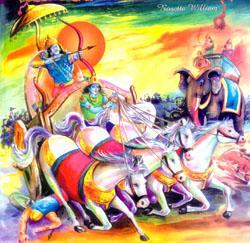| Mahabharata Home |
| Children Story Home Page |
|
Introduction
|
It is the story the Pandavas and the Kauravas - two branches of the royal clan of the Kurus who lived in northern India many thousands of years ago. Often called the 'fifth veda' one can find nearly every branch of knowledge in it. In its pages are woven, history legend, myths, folklore, fable, parable, philosophy, religion, statecraft, martial outs, ethics and romance. The Mahabharata has also traveled overseas to other Asian countries like Thailand, Indonesia and Cambodia. The characters have assumed the respective local flavour and the various versions differ from each other, but the basic story remains the same. It is this basic story, with its several side stories and legends, that has been retold here in an abridged form. Through the small and large events-some comic, some tragic, some beautiful and others ugly - the story builds towards its bitter and tragic climax. The uniqueness of Mahabharata is that no single character be it the 'heroes' Yudhishthira, and Arjuna, or the 'Villains' Duryodhana and Shakuni is completely good or evil. Each has his or her own nobility and a part to play in the unfolding tragedy. The blind king Dhritarashtra, loving, but weak, his wife Gandhari- who understands, but blindfolds herself and refuses to 'see'; the gentle Yudhishthira - who abhors wars but who is open to manipulation by the unscrupulous - are all part of the story. Intensely human in their passionate loves and hates, joys and sorrows, the characters of the epic have recognizable counterparts in all ages and civilizations. |
